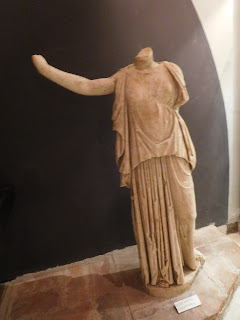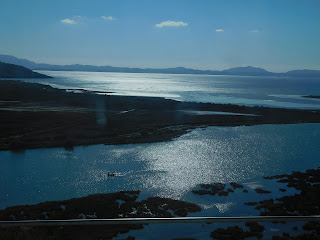When we walked down to the waterfront after a filling breakfast provided by our hotel in Saranda, it was impossible to miss the huge Holland America ship that had anchored at sea overnight. We were on our way to view the ancient ruins of Butrint, an UNESCO World Heritage site, located about 12 miles south of Saranda.
On the bus I began chatting with a Canadian couple from BC who were passengers on the ship. They asked if we were too, when they saw me taking photos of it. I said, no but that was the closest we’d get and I was living vicariously!
A number of people got off the bus in the village of Ksamili which was about halfway to Butrint. It’s known for its beautiful beach with several small islands you could swim to. Ksamili is now heavily developed, with a large number of partially completed properties. It was extraordinary to see that some of these new buildings were toppling over. This is believed to be where buildings have gone up without permission, and the police have sabotaged the building by pulling out a couple of upright pillars, leaving the owner to clear up the damage!
The sign at the ticket entrance to Butrint National Park was certainly thought provoking. It stated that in 2014, there were 20,000 more visitors than in 2013; in 2015, nearly 40,000 more than 2014. In 2014, the number of visitors exceeded 100,000. They estimated that there would be more than 150,000 this year and asked rhetorically, is this success? It’s hardly surprising that Butrint is the most visited cultural tourist destination in Albania.
Although Butrint had been inhabited long before, Greeks from Corfu settled on the hill in the 6th century BC. Within a century Butrint had become a fortified trading city with an acropolis. The lower town began to develop in the 3rd century BC and many large stone buildings had been built by the time the Romans took over in 167 BC.
Butrint’s prosperity continued throughout the Roman period and the Byzantines made it an ecclesiastical center. The city was finally abandoned during the Middle Ages perhaps due to the marsh surrounding and subsequent malaria epidemic. It was abandoned until 1927 when Italian archeologists arrived.Shortly after we entered the site, the path led to Butrint’s 3rd century BC Greek Theater that was secluded in the forest under the acropolis. Also in use during the Roman period, it could seat 2,500 people. There were waves and waves of tourists who arrived from the ship, almost all of whom were led by tour guides carrying paddles aloft to keep their charges in tow so they wouldn’t stray; oops, I mean get lost!
I enjoyed listening to the guides at times so I could derive important nuggets of information about what we were seeing. But we were lucky not to be on any schedule so we could linger in the theater as long as we wanted. The amphitheater is used as a performance venue by world amateur theater troops at the annual festival.
Close by the Theater were the small 2nd century Roman baths whose geometric mosaics were buried under a layer of mesh and sand to protect them from the elements.
The Roman Forum was the civic and commercial center of the city and also used for worship. The remains of the forum, first discovered in 2005, included a 2,000 year old stone pavement that measured about 9,000 square feet! Most of the forum still lies under about six feet of soil.
The forum was once lined by major Roman buildings including temples adorned with frescoes and marble. It was destroyed by a major earthquake in the 4th century AD.
Butrint had many townhouses and villas. One original townhouse was deveoped into the great Triconch Palace around 400 AD with the expansion of the original courtyard and a new wing.
Deeper in the forest was a 6th century Baptistery. I heard a guide explain the circular form was unusual as normally it was rectangular only. The font was in the middle with the cross.
Beyond the Baptistery were the impressive arches of the Great Basilica from the 12th century Roman period. It is the largest in the world after Hagia Sophia in Istanbul!
These three niches outside the Basilica originally had statues.
A little piece of the Basilica mosaic floor was left uncovered for all to see.
I found the Great Basilica the most interesting sight so far, possibly because I could tell that's what it had been!
It was so incredibly peaceful and quiet at this spot off the literally beaten path that we decided to just sit on the rocks and read. The water was a lovely shade of green and there were the same pinkish red color grasses or water plants we’d seen at Blue Eye Spring a couple of days ago.
We watched as these fishermen tried their luck at net fishing. We were there for a good 40 or so minutes and we never did notice their pulling in any fish (or mussels which are what Lake Butrint is known for) during that time. I guess patience must be the ultimate virtue or characteristic that defines fishermen.
After the lovely break, it was back to seeing more ruins. We overheard a guide state that a sign of Butrint's early fortifications was this gate built off to the side so the enemies couldn’t see it upon approach by water.
The inhabitants were protected from invaders by massive city walls
Next we came across the beautifully carved Lion Gate. The relief showed a lion, the symbol of power, eating the head of a bull. It represented a protective force vanquishing assailants.
We next headed up to the top of the hill where the Acropolis once was. On the way there were some more lovely views of Lake Butrint.

Archeologists found traces of early use in the castle area dating back to the 8th century BC.18,000 years ago, the landscape around Butrint was very different from what it is today. Sea levels were much lower and the Greek island of Corfu was joined to the mainland.
Nine thousand years ago, the sea rose and the surrounding hills became small islands. Since then, rivers and rain carried silt and clay from the mountains to the coast and what was once sea, slowly became salt marsh and later dry land. Stone tools discovered on these former islands demonstrate that the area has been occupied since pre-historic times.
The castle housed the very informative Butrint Museum.
Statue of Artemis, goddess of the hunt.
Manumission, the freeing of slaves: One of the most remarkable finds at Butrint was a series of inscribed stones that recorded the freeing of slaves.The inscriptions were found in two places: first on the wall of the theater, and second, as a series of blocks resused in a later tower. As well as recording the names of the slave owners, I was amazed to learn the inscriptions also gave information about how the region was governed through a complex system of administrative bodies.
The inscriptions revealed that the role of women in Butint was very different than that in classical Greece. Women were able to own and release slaves themselves and, in the event of the husband's death, the property would pass to the wife and not the eldest son.
Caesar’s Legacy: Shortly before his death in 44 BC, Julius Caesar founded a Roman colony at Butrint which was further developed under the reign of Augustus. For a brief period, the people who shaped the future of the Roman world took a personal interest in the town.
Much of what we know of Butrint's history comes from the writings of Cicero, the famous Roman orator and politician. Cicero's friend, Atticus, who owned an estate near Butrint, was concerned at the potential loss of land associated with the arrival of colonists. He pleaded with Cicero to lobby on his behalf to prevent the foundation of the colony.
The Baptistery mosaic is the largest and most complete of any baptistery in the Roman world.
Here are some mosaic details and their religious significance that I found of particular interest.
In the castle courtyard was a marble bust of Apollo that was discovered by an Italian archeologist in 1928. For many years the bust was in Italy before being returned to Albania in 1981 where it was displayed at the National Historical Museum in Tirana.
As we left the museum to walk back to the bus stop, we saw some seriously tall cactus!
By the exit, the Phoenician Tower was now used as an office, I discovered, upon walking up the steps and across the drawbridge and poking my head in the door. Guess I should not have let my curiosity get the upper hand!
I read that what we saw at Butrint was just 15 percent of what lies beneath as international archeological teams are still performing excavations. I am not sure, however, if that is current or old information.
I would imagine this was the smallest ferry we had ever seen. It was a combination of car and passenger ferry depending on the need of the moment. The low tech ferry crossing had little impact on the environment.
The ferry enabled visitors to easily see the Triangular Fortifications on the other side of the lake if they had not already had their fill of archeological wonders - we had!
The fascinating little ferry worked on a pulley system.
Our bus ride back to Saranda:
Mussell fish farming:
Nighttime in Saranda:
Are we creatures of habit or what: I with my pizza and Steven with yet another plate of spaghetti!
Our day at Butrint had been a lovely combination of interesting ruins, ideal weather, pretty scenery, relaxing down time and, as always, perfect company.
Posted from Santorini, Greece on October 15th , 2016.

















































































"Our day at Butrint had been a lovely combination of interesting ruins, ideal weather, pretty scenery, relaxing down time and, as always, perfect company"...perfect last line of a post .. add to that, a photo of you smiling at the photographer (your wonderful travel and soul mate, Steven) ... that's perfection ! xo Lina
ReplyDeleteLina,
DeleteJust saw your comment now all these years later! Thanks for your sweet comment.
Cool stuff you have got and you keep update all of us. dotcom secrets pdf
ReplyDeleteWelcome to the blog, Sameer. Glad you enjoyed the post.
Delete